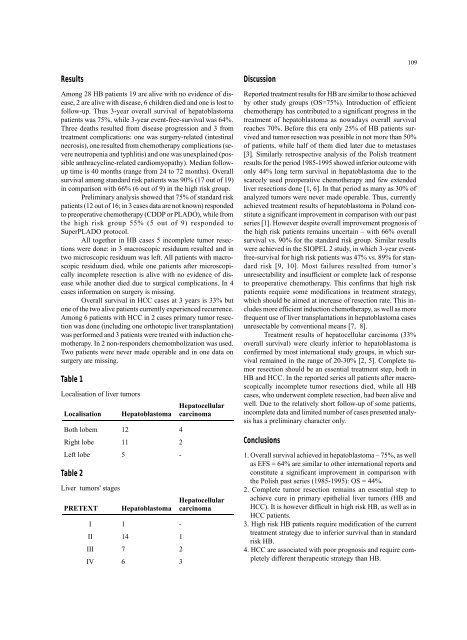Annals of Diagnostic Paediatric Pathology
Annals of Diagnostic Paediatric Pathology
Annals of Diagnostic Paediatric Pathology
You also want an ePaper? Increase the reach of your titles
YUMPU automatically turns print PDFs into web optimized ePapers that Google loves.
109<br />
Results<br />
Among 28 HB patients 19 are alive with no evidence <strong>of</strong> disease,<br />
2 are alive with disease, 6 children died and one is lost to<br />
follow-up. Thus 3-year overall survival <strong>of</strong> hepatoblastoma<br />
patients was 75%, while 3-year event-free-survival was 64%.<br />
Three deaths resulted from disease progression and 3 from<br />
treatment complications: one was surgery-related (intestinal<br />
necrosis), one resulted from chemotherapy complications (severe<br />
neutropenia and typhlitis) and one was unexplained (possible<br />
anthracycline-related cardiomyopathy). Median followup<br />
time is 40 months (range from 24 to 72 months). Overall<br />
survival among standard risk patients was 90% (17 out <strong>of</strong> 19)<br />
in comparison with 66% (6 out <strong>of</strong> 9) in the high risk group.<br />
Preliminary analysis showed that 75% <strong>of</strong> standard risk<br />
patients (12 out <strong>of</strong> 16; in 3 cases data are not known) responded<br />
to preoperative chemotherapy (CDDP or PLADO), while from<br />
the high risk group 55% (5 out <strong>of</strong> 9) responded to<br />
SuperPLADO protocol.<br />
All together in HB cases 5 incomplete tumor resections<br />
were done: in 3 macroscopic residuum resulted and in<br />
two microscopic residuum was left. All patients with macroscopic<br />
residuum died, while one patients after microscopically<br />
incomplete resection is alive with no evidence <strong>of</strong> disease<br />
while another died due to surgical complications. In 4<br />
cases information on surgery is missing.<br />
Overall survival in HCC cases at 3 years is 33% but<br />
one <strong>of</strong> the two alive patients currently experienced recurrence.<br />
Among 6 patients with HCC in 2 cases primary tumor resection<br />
was done (including one orthotopic liver transplantation)<br />
was performed and 3 patients were treated with induction chemotherapy.<br />
In 2 non-responders chemombolization was used.<br />
Two patients were never made operable and in one data on<br />
surgery are missing.<br />
Table 1<br />
Localisation <strong>of</strong> liver tumors<br />
Localisation<br />
Hepatoblastoma<br />
Both lobem 12 4<br />
Right lobe 11 2<br />
Left lobe 5 -<br />
Table 2<br />
Liver tumors' stages<br />
PRETEXT<br />
Hepatoblastoma<br />
I 1 -<br />
II 14 1<br />
III 7 2<br />
IV 6 3<br />
Hepatocellular<br />
carcinoma<br />
Hepatocellular<br />
carcinoma<br />
Discussion<br />
Reported treatment results for HB are similar to those achieved<br />
by other study groups (OS=75%). Introduction <strong>of</strong> efficient<br />
chemotherapy has contributed to a significant progress in the<br />
treatment <strong>of</strong> hepatoblastoma as nowadays overall survival<br />
reaches 70%. Before this era only 25% <strong>of</strong> HB patients survived<br />
and tumor resection was possible in not more than 50%<br />
<strong>of</strong> patients, while half <strong>of</strong> them died later due to metastases<br />
[3]. Similarly retrospective analysis <strong>of</strong> the Polish treatment<br />
results for the period 1985-1995 showed inferior outcome with<br />
only 44% long term survival in hepatoblastoma due to the<br />
scarcely used preoperative chemotherapy and few extended<br />
liver resections done [1, 6]. In that period as many as 30% <strong>of</strong><br />
analyzed tumors were never made operable. Thus, currently<br />
achieved treatment results <strong>of</strong> hepatoblastoma in Poland constitute<br />
a significant improvement in comparison with our past<br />
series [1]. However despite overall improvement prognosis <strong>of</strong><br />
the high risk patients remains uncertain – with 66% overall<br />
survival vs. 90% for the standard risk group. Similar results<br />
were achieved in the SIOPEL 2 study, in which 3-year eventfree-survival<br />
for high risk patients was 47% vs. 89% for standard<br />
risk [9, 10]. Most failures resulted from tumor’s<br />
unresectability and insufficient or complete lack <strong>of</strong> response<br />
to preoperative chemotherapy. This confirms that high risk<br />
patients require some modifications in treatment strategy,<br />
which should be aimed at increase <strong>of</strong> resection rate. This includes<br />
more efficient induction chemotherapy, as well as more<br />
frequent use <strong>of</strong> liver transplantations in hepatoblastoma cases<br />
unresectable by conventional means [7, 8].<br />
Treatment results <strong>of</strong> hepatocellular carcinoma (33%<br />
overall survival) were clearly inferior to hepatoblastoma is<br />
confirmed by most international study groups, in which survival<br />
remained in the range <strong>of</strong> 20-30% [2, 5]. Complete tumor<br />
resection should be an essential treatment step, both in<br />
HB and HCC. In the reported series all patients after macroscopically<br />
incomplete tumor resections died, while all HB<br />
cases, who underwent complete resection, had been alive and<br />
well. Due to the relatively short follow-up <strong>of</strong> some patients,<br />
incomplete data and limited number <strong>of</strong> cases presented analysis<br />
has a preliminary character only.<br />
Conclusions<br />
1. Overall survival achieved in hepatoblastoma – 75%, as well<br />
as EFS = 64% are similar to other international reports and<br />
constitute a significant improvement in comparison with<br />
the Polish past series (1985-1995): OS = 44%.<br />
2. Complete tumor resection remains an essential step to<br />
achieve cure in primary epithelial liver tumors (HB and<br />
HCC). It is however difficult in high risk HB, as well as in<br />
HCC patients.<br />
3. High risk HB patients require modification <strong>of</strong> the current<br />
treatment strategy due to inferior survival than in standard<br />
risk HB.<br />
4. HCC are associated with poor prognosis and require completely<br />
different therapeutic strategy than HB.
















